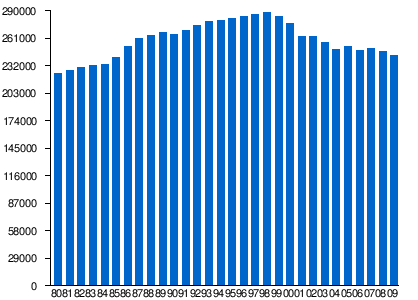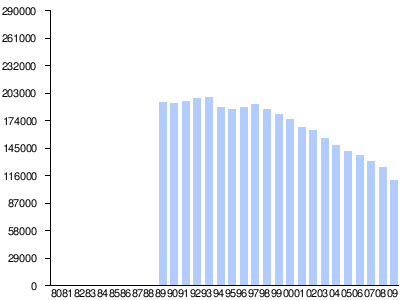Aftenposten
| Type | Daily newspaper |
|---|---|
| Format | Compact |
| Owner | Schibsted ASA |
| Editor | Hilde Haugsgjerd |
| Founded | May 14, 1860 |
| Political alignment | Liberal conservative |
| Language | Norwegian |
| Headquarters | Oslo, Norway |
| Official website | www.aftenposten.no |
Aftenposten (Norwegian for "The Evening Post") is Norway's largest newspaper. It retook this position in 2010, taking it from the tabloid Verdens Gang which had been the largest newspaper for several decades. It is based in Oslo. The morning edition, which is distributed across all of Norway, had a circulation of 250,179 in 2007.[1] In addition, the evening edition, which is only distributed to the populous central eastern part of Norway has a circulation of 131,089. Aftenposten has a long tradition of serious journalism, and is by many considered to be the leading Norwegian newspaper. Strong competition in a shrinking market has made the paper opt for a broader appeal, however, as signified by the conversion from broadsheet to compact format in 2005.
Aftenposten is a private company wholly owned by the public company Schibsted ASA. Aftenposten has approximately 740 employees. Editor-in-chief is Hilde Haugsgjerd (2010).
Contents |
Editions
In addition to the morning edition, Aftenposten publishes a separate evening edition called Aften (previously Aftenposten Aften). This edition was published on weekdays and Saturdays until the Sunday morning edition was reintroduced in 1990. The evening edition is only circulated in the central eastern part of Norway, i.e. Oslo and Akershus counties. Thus, it focuses on news related to this area, in contrast with the morning edition, which focuses on national and international news. The evening edition was converted to tabloid format in 1997. From April 2006, the Thursday edition of Aften also includes a special edition with news specific to a part of Oslo or Akershus, called Lokal Aften ("Local Evening"). There are eight versions of this edition, each subscriber receives the version which is most relevant to the area in which he or she lives. In areas that are not covered by any of the eight versions (for example Romerike and Follo), the version for central Oslo is distributed. From May 2009 Aften is only printed and distributed 3 days a week, Tuesday to Thursday.
History
Aftenposten was founded by Christian Schibsted May 14, 1860 under the name "Christiania Adresseblad". The following year it was renamed Aftenposten. Since 1885 the paper has printed two daily editions. A Sunday edition was published until 1919, and was reintroduced in 1990. The Friday morning edition carries the A-magasinet supplement, featuring articles on science, politics, and the arts.
Historically, Aftenposten labelled itself as "independent, conservative", most closely aligning their editorial platform with the Norwegian conservative party, Høyre. This manifested itself in blunt anti-communism during the inter-war era. During the Second World War Aftenposten, due to its large circulation, was put under the directives of the German occupational authorities, and a Nazi editorial management was imposed.
Controversies
Aftenposten has not received the amount of lawsuits and attention from the Norwegian press association Norsk Presseforbunds committee for press affairs that some of the larger tabloids have. However, there are exceptions. In 2007 Aftenposten alleged that Julia Svetlichnaja, the last person to interview the murdered Russian national Alexander Litvinenko, was a Kremlin agent. London correspondent Hilde Harbo admitted to have let herself be fed disinformation from the Russian emigrant community, without investigating the matter properly.[2] Aftenposten eventually had to apologize, and pay Ms Svetlichnaja's legal costs.
Editorial line
Aftenposten is now seldom regarded as a conservative newspaper; right-leaning critics have often pointed out that the paper has become mainstream social-democratic after the end of the Cold War, thus in essence politically aligned with a large majority of Norway's press.
Language
True to its conservative line, Aftenposten is published in a very conservative form of the Norwegian written language called Riksmål, which keeps closer ties to the Danish language than more commonly used norms. In 1990, Aftenposten adopted the latest Riksmål spelling standard of 1986 as its language guideline. This language standard is maintained by a private organization called Riksmålsforbundet, and not by the official Norwegian language council Norsk språkråd. As such it is not an officially accepted norm for Norwegian written language. Since it is largely compatible with the most conservative form of the officially sanctioned, and more common norm Bokmål, this is somewhat less controversial than one would assume. However, Aftenposten has been under repeated criticism for its very strict editorial policy on this matter; mainly because it converts every contribution to the newspaper, including letters from readers, into this language standard - even if they were correctly written according to official language guidelines.
The online version of the paper had a large English section, and is one of the favourite sources for Norwegian news in English amongst the Norwegian diaspora, people of Norwegian descent who live abroad (i.e. in the USA), and others with an interest in Norway. Since early November 2008, Aftenposten no longer publishes stories in English in a cost cutting move. Archives of past material are still available online.[3]
Circulation
Aftenposten (morning paper)
Numbers from the Norwegian Media Businesses' Association, Mediebedriftenes Landsforening 1980 - 2009:
|
|
|
Aften (evening paper)
Numbers from the Norwegian Media Businesses' Association, Mediebedriftenes Landsforening: 1989 - 2009:
|
|
|
See also
- List of Norwegian newspapers
- List of non-English newspapers with English language subsections
- Radio Gaga
References
- ^ Medienorge - fakta om norske massemedier - hovedsiden (Norwegian)
- ^ "Svetlichnaja and Litvinenko: Clarifications - Aftenposten.no". Aftenposten.no. 2006-12-09. http://www.aftenposten.no/english/local/article1972241.ece. Retrieved 2009-02-01.
- ^ "So long, farewell ...". Aftenposten. 5 November 2008. http://www.aftenposten.no/english/local/article2741143.ece. Retrieved 20 November 2008.
External links
- Aftenposten (online) in English
- Aftenposten.no in Norwegian
- Old Aftenposten (1870-1905) at Norway National Library's digital archive
- Thumb-size picture of the morning front page
|
||||||||||||||||||||

